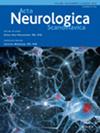Risk Factors of Oropharyngeal Dysphagia and Malnutrition in Neurological Patients
Abstract
Background
Oropharyngeal dysphagia (OD) and malnutrition are prevalent among neurological patients, particularly those with cerebrovascular disease and neurodegenerative conditions. Both conditions can significantly impact the health and recovery of these individuals. The study was aimed at identifying risk factors associated with OD and malnutrition, using the biopsychosocial model to explore the relationships between these outcomes and various risk factors, including body structures, body functions, level of activity and participation, and contextual factors.
Methods
This cross-sectional study included 144 neurological patients, aged 19–93 years. Data were collected on a range of factors, including oral and pharyngeal structures, appetite, cognitive function, and social participation. The prevalence of OD and malnutrition was assessed using the Standardized Swallowing Assessment and Global Leadership Initiative on Malnutrition (GLIM) criteria. Risk factors were evaluated using logistic regression models based on the biopsychosocial model.
Results
The prevalence of OD and malnutrition in the study sample was 27.1% and 35.4%, respectively. Significant risk factors for OD included impaired oral structures (tongue, lips, and soft palate), cognitive dysfunction, and appetite loss. Malnutrition was associated with soft palate impairment, reduced calf circumference, weight loss, and social isolation. Higher scores in the WHO Disability Assessment Schedule (WHODAS 2.0) getting along domain (indicating poor social functioning) and living alone were linked to increased malnutrition risk. No significant relationship was found between environmental factors or health conditions and OD or malnutrition. While most dysphagia patients retained some ability to eat orally, dietary adaptations were frequently required.
Conclusion
This study highlights the high prevalence of OD and malnutrition among neurological patients and identifies key risk factors, including both physical impairments and psychosocial elements. Early screening and targeted interventions, such as dietary modifications and cognitive support, are essential for improving patient outcomes. A biopsychosocial approach is effective in understanding the multifactorial nature of these conditions and informs clinical practice. Future longitudinal studies are necessary to better understand causal relationships and enhance the generalizability of these findings.


 求助内容:
求助内容: 应助结果提醒方式:
应助结果提醒方式:


